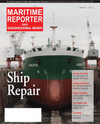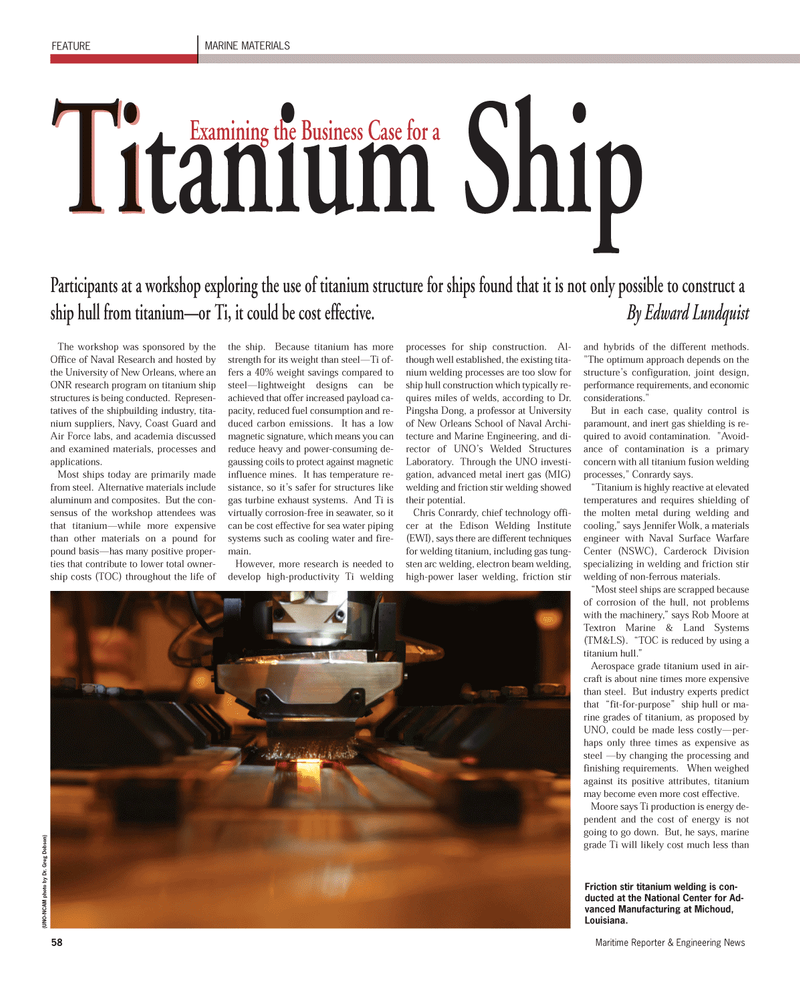
Page 58: of Maritime Reporter Magazine (March 2012)
The Ship Repair Edition
Read this page in Pdf, Flash or Html5 edition of March 2012 Maritime Reporter Magazine
The workshop was sponsored by the Office of Naval Research and hosted by the University of New Orleans, where an ONR research program on titanium shipstructures is being conducted. Represen-tatives of the shipbuilding industry, tita- nium suppliers, Navy, Coast Guard and Air Force labs, and academia discussed and examined materials, processes and applications.Most ships today are primarily madefrom steel. Alternative materials include aluminum and composites. But the con-sensus of the workshop attendees was that titanium?while more expensive than other materials on a pound forpound basis?has many positive proper- ties that contribute to lower total owner- ship costs (TOC) throughout the life of the ship. Because titanium has morestrength for its weight than steel?Ti of- fers a 40% weight savings compared to steel?lightweight designs can beachieved that offer increased payload ca- pacity, reduced fuel consumption and re- duced carbon emissions. It has a low magnetic signature, which means you canreduce heavy and power-consuming de- gaussing coils to protect against magnetic influence mines. It has temperature re-sistance, so it?s safer for structures like gas turbine exhaust systems. And Ti is virtually corrosion-free in seawater, so it can be cost effective for sea water piping systems such as cooling water and fire- main.However, more research is needed to develop high-productivity Ti welding processes for ship construction. Al- though well established, the existing tita- nium welding processes are too slow for ship hull construction which typically re-quires miles of welds, according to Dr. Pingsha Dong, a professor at University of New Orleans School of Naval Archi- tecture and Marine Engineering, and di-rector of UNO?s Welded Structures Laboratory. Through the UNO investi- gation, advanced metal inert gas (MIG) welding and friction stir welding showed their potential.Chris Conrardy, chief technology offi- cer at the Edison Welding Institute (EWI), says there are different techniques for welding titanium, including gas tung- sten arc welding, electron beam welding,high-power laser welding, friction stir and hybrids of the different methods. "The optimum approach depends on thestructure?s configuration, joint design, performance requirements, and economicconsiderations." But in each case, quality control isparamount, and inert gas shielding is re- quired to avoid contamination. "Avoid- ance of contamination is a primaryconcern with all titanium fusion weldingprocesses," Conrardy says.?Titanium is highly reactive at elevated temperatures and requires shielding ofthe molten metal during welding andcooling,? says Jennifer Wolk, a materials engineer with Naval Surface Warfare Center (NSWC), Carderock Division specializing in welding and friction stirwelding of non-ferrous materials.?Most steel ships are scrapped becauseof corrosion of the hull, not problemswith the machinery,? says Rob Moore at Textron Marine & Land Systems (TM&LS). ?TOC is reduced by using a titanium hull.? Aerospace grade titanium used in air- craft is about nine times more expensive than steel. But industry experts predict that ?fit-for-purpose? ship hull or ma- rine grades of titanium, as proposed byUNO, could be made less costly?per- haps only three times as expensive as steel ?by changing the processing andfinishing requirements. When weighed against its positive attributes, titanium may become even more cost effective. Moore says Ti production is energy de- pendent and the cost of energy is not going to go down. But, he says, marine grade Ti will likely cost much less than 58Maritime Reporter & Engineering News FEATURE MARINE MATERIALS Friction stir titanium welding is con-ducted at the National Center for Ad-vanced Manufacturing at Michoud,Louisiana. (UNO-NCAM photo by Dr. Greg Dobson) Participants at a workshop exploring the use of titanium structure for ships found that it is not only possible to construct a ship hull from titanium?or Ti, it could be cost effective. By Edward Lundquist TiTitanium Ship Examining the Business Case for a MR March 12 # 8 (56-64):MR Template 3/6/2012 9:34 AM Page 58

 57
57

 59
59
